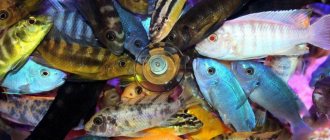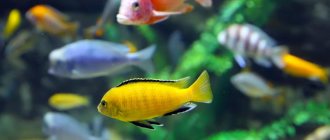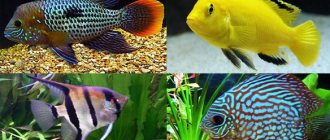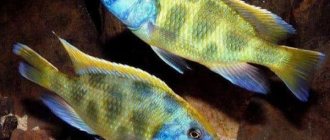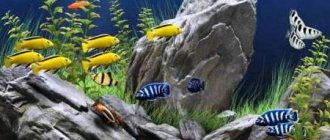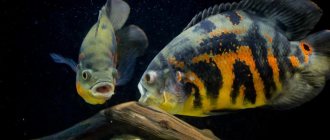The African continent is home to a huge number of fish species representing the large and diverse family of Cichlids (or Cichlids). A significant part of them are endemic (that is, they are not found anywhere else in the world). The geographic centers of cichlid habitat are the Great African Lakes (Victoria, Malawi, Tanganyika), as well as many smaller bodies of water (other lakes, rivers, streams).
The Great Lakes are virtually isolated bodies of water that formed on faults in tectonic plates many millions of years ago. This explains the special composition of the water - it is consistently hard, alkaline, and sometimes brackish.
The hydrobionts inhabiting the lakes have been isolated from other bodies of water throughout the history of their development, and therefore have formed thousands of unique species, up to 95% of which are found only in narrow habitats.
Huge lakes are conventionally divided into biotopes (surf zone, rocky or sandy bottom, deep layers of water), and each niche is literally teeming with life.
These aquarium fish, so desirable and valuable all over the world, are mostly commercial fish for the natives of Africa. Over the past couple of decades, African authorities have limited fishing (especially for export) due to declining populations and the threat of extinction of many species. Fortunately, all cichlids reproduce safely in captivity.
Description
Cichlids are divided into many species, differing from each other in size, body shape, color, and degree of aggressiveness towards other fish. All are united by belonging to the order Perciformes. The dorsal fins of Malawi fish are elongated and the rays are hard. The same applies to the anal fins. The color of the fish is very bright, the color palette is diverse.
Features of behavior
Malawian cichlids are active fish. They are constantly on the move, swimming around the entire aquarium, playing with each other, digging in the soil. They treat other fish that permanently live in the same territory with them with loyalty. Newcomers may be greeted aggressively and begin to chase them around the territory.
Newly acquired fish will most likely hide in hiding when they see a person. However, having gotten used to the new habitat, it soon begins to recognize the owner and, when he approaches the aquarium, swims towards him, begging for food.
Malawians are distinguished by their special attitude towards their offspring. Having laid eggs, fish carry them in their mouths, protecting them from enemies. The emerging fry can also hide in the throat pouch of their parents. In some species, only the female takes care of the babies, in others, both parents take care of them together.
Homeland of Malawian cichlids
In nature, these fish live only in the African Lake Malawi, where their distant ancestors came from neighboring Tanganyika. Over thousands of years, about five hundred new species have formed here, each of which has its own characteristics of appearance and behavior. The evolution continues to this day. Lake Malawi is deep with clear water and varied bottom topography. That is why new species are formed here so easily. Fish adapt to different conditions, acquire new colors and ways of protecting themselves from enemies. One thing remains in common: these fish carry fertilized eggs in their mouths. At first, the fry also hide in their parents’ mouths at the slightest threat. These are the conditions of survival in Malawi.
Some species of cichlids are of commercial importance to humans, while others are decorative and thrive in home and office aquariums.
Kinds
It is customary to divide Malawian cichlids into two main groups:
- Mbuna.
- Utaka.
Mbuna cichlids are herbivores. They feed on algal fouling. These fish naturally live near the coast. They prefer aquariums with an abundance of plants. Mbuna are small cichlids, their body size does not exceed 12 cm. In all varieties of this group, the color of the fish throughout life is very bright, and males and females have no differences in color.
An indicative representative of this group are Pseudotropheus. Among other species they are distinguished by their teeth of an unusual double-topped shape. The most common body pattern is vertical stripes. Males guard the boundaries of their territories. Females and juveniles live in flocks.
Pseudotropheus
The second group is predators. Utaka are distinguished by their larger sizes, reaching up to 25 cm. Under natural conditions, they live in open water. Aquariums for this group are decorated with stones and grottoes; plants are not planted. At birth, the fish have a neutral color and only upon reaching sexual maturity do the males acquire a brighter color. Females remain gray.
Health and disease in aquarium keeping
Cichlids from the African Great Lakes are not fish that are highly susceptible to any disease. In addition, these animals are not sensitive to pathogens and other parasites. However, due to non-compliance with appropriate conditions of detention, some problems are possible.
To prevent the development of pathogenic organisms in the aquarium, artificial conditioners such as Methylene Blue and Malachite Green and the disinfectant Sidex are used.
Sometimes fish get sick with a disease such as dropsy or ascites. Develops due to improper care of the water in the vessel. A sign of the disease are protruding scales. The influence of low quality water first leads to a decrease in appetite in cichlids, then their scales begin to protrude. After a few days the fish dies.
If you find an individual swimming on its side or moving head down, this may indicate an inflammatory process in the swim bladder. Such trouble can occur as a result of improper transportation of fish, after a fight between males, and also as a result of various types of infections.
Important! In the early stages of the disease, treatment with drugs is possible. It is advisable to quarantine all fish that look questionable or are already sick. It is also necessary to keep newly purchased samples here for some time.
We list other possible diseases of cichlids:
- Malawi disease;
- oodiniosis;
- ichthyophthyriosis;
- argulosis;
- various intestinal parasites;
- lernea;
- hexamitosis;
- bulging eyes;
- fin rot.
Video: 5 of the most terrible diseases of aquarium fish Thus, Malawian cichlids can safely be called one of the most colorful representatives of the underwater fauna of the entire African continent. Keeping cichlids at home will be an unforgettable experience for connoisseurs of aquarium fish.
Compatibility with other inhabitants
Cichlids of different species in the same aquarium should be the same size to avoid fights. It is desirable that there is only one male in each species. It is generally accepted that representatives of only one group, either Mbuna or Utaka, can be housed in a cichlid because of the difference in diet. However, on thematic forums discussing compatibility, you can find stories about the completely peaceful existence of fish of both groups in the same aquarium. With the caveat that they grew up together from juvenile age.
Caring for Cichlids
Malawians are fairly easy to care for. It is only important to systematically perform certain duties.
- Weekly water changes. The volume is about a quarter of an aquarium.
- Regular soil cleaning. To clean the soil, you can use a special aquarium siphon and combine this process with water changes.
- Maintaining the required water parameters. Temperature 24-28°C, hardness from 6 to 10, pH (acidity) 7.5-8.5. In principle, the water parameters for keeping cichlids are average, and it is usually not difficult to maintain them.
- Filtration.
- Constant aeration.
- Correct dosage of feed.
How long do cichlids live in captivity? With proper care, the life expectancy of Malawian cichlids is 5-8 years. The diseases that cichlids are susceptible to are the usual list of fungal infections, outbreaks of which occur due to improper husbandry. If you have provided the fish with good care, they should not get sick.
Reproduction
Malawian cichlids become more colorful before spawning and tend to prepare a nest. If fish do not want to reproduce on their own, they can be provoked by increasing the water temperature to 27–28 °C. The female lays eggs and places them next to the male's anal fin. Next, fertilization occurs. After which the female takes the eggs into her mouth. Until the fry hatch, she does not eat anything and vigorously moves her gills to ensure the flow of oxygen to future offspring. Sometimes the parents eat the first clutch. But usually adult fish strongly protect both eggs and fry.
Content
Before you get cichlids, be sure to set up an aquarium. The soil should be of medium size - not sand or large stones. Snow-white quartz is often used in cichlid fish; it not only matches the characteristics, but also has an elegant appearance. Cichlids always need shelters and burrows, space to swim and privacy. To create a biotope similar to the bottom of Lake Malawi, piles of sandstone, grottoes, pots, and ceramic tunnels are often used.
The volume of the aquarium for most species of cichlids starts from 100 liters (usually even from 150 liters). This is a very important parameter, since in a small aquarium, if there is overpopulation, the fish will not grow, will not acquire all the beautiful colors and will ultimately fight over the territory, leaving the most aggressive and strong ones. If you have only one adult cichlid left, you will not be able to add fry to it, even if they are of the same breed. She will eat them, preserving the peace of her space.
Features of Lake Malawi
Lake Malawi, which gave the name to the fish, is located in East Africa and has another name - Nyasa. It has an elongated shape and lies on the territory of three countries: Malawi, Tanzania and Mozambique. Nyasa is a large lake, ranked third in the world in depth and ninth in area. The length is 584 km, the width at the narrowest point is 16 km, at the widest point it is 80 km, and the depth is 706 m.
14 rivers flow into the lake, but only one flows out of it. A constant volume of water is maintained by evaporation. This is the reason for increased hardness and some saltiness.
The bottom of Malawi is rocky and consists of sedimentary rocks up to 4 km thick.
Nyasa has a very developed and diverse ecosystem. The lake is home to up to 1 thousand species of fish, represented by 11 families. The most numerous of them are Malawi cichlids. Its representatives make up 90% of the fish living in the lake.
Lake Nyasa fish are actively caught. Some species are commercially available and can be found in our grocery stores (tilapia). Malawians are also sold to aquarists all over the world.
Feeding
Feeding a cichlid is also easy. You can give special dry food for cichlids, which contains substances to maintain color. Malawian cichlids, as already mentioned, are not averse to eating live food (just make sure that the food fits into the fish’s mouth, otherwise it may choke without calculating its strength). Even mbuna, which in nature feed mainly on plant food, will happily start eating bloodworms in an aquarium. Good nutrition is the key to proper development, rapid growth of fish and their ability to reproduce. The number of feedings per day is 2-3 for fry, adults can be fed once. Make sure that the fish eat all the food within 5-7 minutes. If they eat it, reduce the portion.
Mbuna
A territorial aggressive fish species, the male carefully guards his territory, attacking any uninvited guest. They live along the rocky coast, hiding in numerous crevices, grottoes and caves. The brightest and most colorful representatives among the entire family of cichlids. Very popular among aquarists, although they have high demands on their maintenance. Many species of this group are successfully adapted to the artificial environment of the aquarium.
Blue zebra
Blue zebra, scientific name Maylandia callainos, belongs to the family Cichlidae (Cichlidae).
Blue Pindani
Pseudotropheus Socolofi or Blue Pindani, scientific name Pseudotropheus socolofi, belongs to the family Cichlidae
Zebra Mbuna
Mbuna's zebra, scientific name Maylandia zebra, belongs to the family Cichlidae
Golden cichlid
The golden cichlid, scientific name Melanochromis auratus, belongs to the family Cichlidae
Red zebra
The red zebra cichlid, scientific name Maylandia estherae (formerly called Pseudotropheus estherae), belongs to the family Cichlidae
Labeotropheus
Labeotropheus vulgaris, scientific name Labeotropheus trewavasae, belongs to the family Cichlidae
Lavender Mbuna
Iodotropheus Sprenger or Lavender Mbuna, also known as the "Rusty" Cichlid, scientific name Iodotropheus sprengerae, belongs to the family Cichlidae
Lombardo
Lombardo, scientific name Maylandia lombardoi, belongs to the family Cichlidae
Maingano
Maingano, scientific name Pseudotropheus cyaneorhabdos, belongs to the family Cichlidae
Melanochromis Johana
Melanochromis johannii, scientific name Pseudotropheus johannii (other common name Melanochromis johannii), belongs to the family Cichlidae
Melanochromis Chipoka
Melanochromis Chipoka, scientific name Melanochromis chipokae, belongs to the family Cichlidae
Pseudotropheus Aki
Pseudotropheus Aki (Acey), scientific name Pseudotropheus sp. "acei", belongs to the family Cichlidae
Pseudotropheus Daktari
Pseudotropheus Daktari, scientific name Maylandia sp. Daktari, belongs to the family Cichlidae
Pseudotropheus Demasoni
Pseudotropheus demasoni, scientific name Pseudotropheus demasoni, belongs to the family Cichlidae
Pseudotropheus saulosi
Pseudotropheus saulosi, scientific name Pseudotropheus saulosi, belongs to the family Cichlidae
Doggy Cichlid
The blenny cichlid or Cynotilapia afra, scientific name Cynotilapia afra, belongs to the family Cichlidae
Hummingbird Cichlid
Yellow Cichlid, Labidochromis yellow or Hummingbird Cichlid, scientific name Labidochromis caeruleus, belongs to the family Cichlidae
Tapir Cichlid
Labeotropheus fuelleborna or Tapir Cichlid, also known as Blue Mbuna, scientific name Labeotropheus fuelleborni, belongs to the family Cichlidae
Bumblebee Cichlid
Pseudotropheus Crabro, Chameleon Cichlid or Bumblebee Cichlid, scientific name Pseudotropheus crabro, belongs to the family Cichlidae
Spotted Mbuna
The Spotted Mbuna (OB Mbuna) is a natural color form of some Malawian cichlids found in Lake Nyasa in Africa.
general information
The cichlid family includes many species that differ in the shapes and sizes of the body and fins, and can be painted in different colors. In the aquarium hobby, they even use special coloring of cichlids to give them an unusual shade and appearance. Unfortunately, artificially created pigment does not last long, and its frequent renewal greatly harms the health of pets.
There are freshwater and marine species. Cichlids are common in Latin America, Asia and Africa. In captivity, with very good care, fish can live up to 10 years; in the natural environment, the life expectancy of cichlids is less.
The smallest individuals even in adulthood retain compact body sizes - up to 2 cm. The largest specimens can grow to almost a meter. Such large fish are practically not kept in aquariums.
There are about 1,200 species of cichlids in total. The most popular are angelfish, discus and cichlid fish.
There are only 1200 such fish left
Requirements for conditions of detention
In order for the fish to be healthy and live as long as possible, it is important to follow the basic rules of keeping them. There are cichlidariums on sale - these are aquariums equipped with everything necessary for cichlids, and many professional aquarium stores prepare them taking into account the needs of a particular type of fish. This does not mean that it is impossible to prepare a container for cichlids yourself , but you must follow the following rules:
- The capacity of the aquarium should be from 150 liters, some recommend choosing containers from 200 liters.
- The lighting must be adjusted so that the fish do not suffer from bright rays. It is better to give preference to sources of diffused light.
- The aquarium must be equipped with a filter and a water aerator.
- The water in the container should be replaced weekly.
- Cichlids are capricious and do not like cold water or sudden temperature changes. It is advisable to constantly maintain the water temperature at 27−28°C.
For a comfortable life, fish need shelter, so the aquarium needs to be decorated and divided into zones using stones, vegetation, artificial caves and shelters.
These fish need shelter.
Cichlids do not require specific food, but variety is important for them. To feed the fish, you can use squid fillet, lettuce, mixed feed, dandelions and even beef. All types of food can be constantly alternated.
Fish reproduction
Most often, aquarists buy a small flock of grown fry or caviar. You cannot take very small fish from cichlids. The parent couple has a very hard time with parting with their offspring; this usually ends with the fish killing each other in search of the culprit for the supposed death (loss) of the children.
Cichlids that have been successfully raised in a school choose their own mate. This usually occurs at an early age before puberty. The formed couple tries to behave alone. They will need a separate shelter for breeding. Future parents do not participate in the affairs of the pack, and when strangers approach the shelter, they can attack and eat the trespasser. Due to the high level of aggression of fish, experienced aquarists usually try to move future parents into a separate aquarium.
These fish choose their own mates
Features of behavior
Cichlids are considered intelligent due to their behavioral characteristics. The fish quickly get used to one owner and willingly take food from his hands. But if the owner skips feeding, keeps the aquarium in poor condition, or separates the formed pair, cichlids can become “offended.” Losing trust in a person is not a momentary phenomenon. Even if the separated couple is brought back together, both fish will show a cool attitude towards the owner for several years.
In mixed schools consisting of more than just cichlids, one of the fish can take on the functions of a protector. Such a guardian of order will stop skirmishes, disperse fighters and protect herbivorous neighbors from the aggressive antics of predatory cichlids.
Caring for the offspring also affects the relationship between the fish in the school. It is known that during the first spawning in captivity, young females can kill their fry. The attitude towards such females is sharply negative ; members of the pack may even try to kill a negligent mother. In this case, relocating the female for a long time will not help. They will no longer try to kill the fish returned to its original aquarium, but they will not be accepted into the school again.
Each school of such fish has “defenders”
Aquarium lighting
Make sure you have fluorescent lighting. Fluorescent lights provide the correct spectrum for healthy fish growth. They produce less heat than incandescent bulbs, which can potentially heat water to dangerous levels.
Another great benefit is that they bring out the natural color of your fish. But keep in mind that if the lighting is too bright, the colors of the fish may be washed out, and the cichlids themselves will be nervous and irritable. White lighting would be an excellent option.
